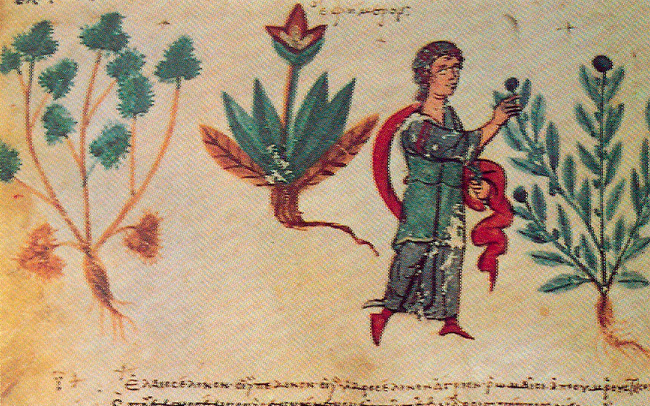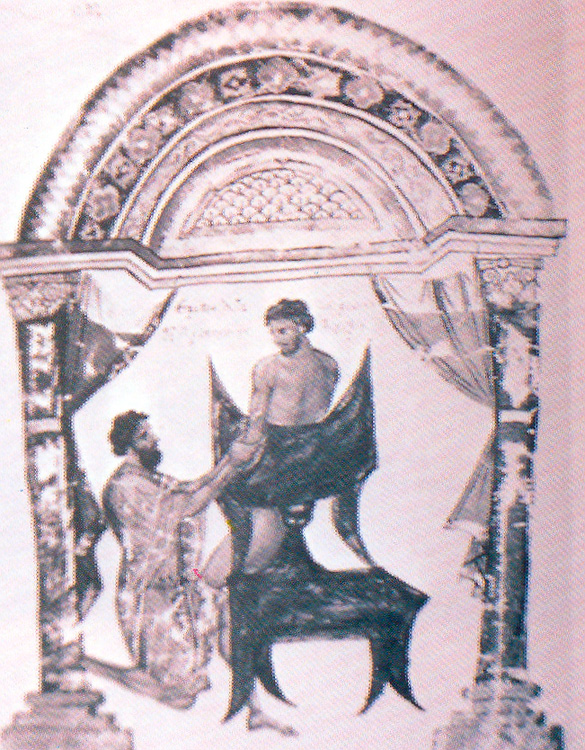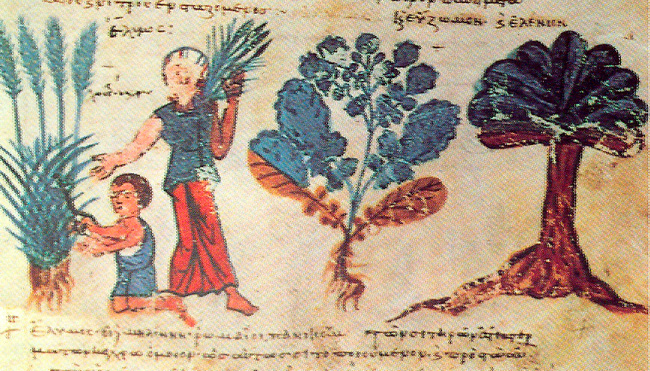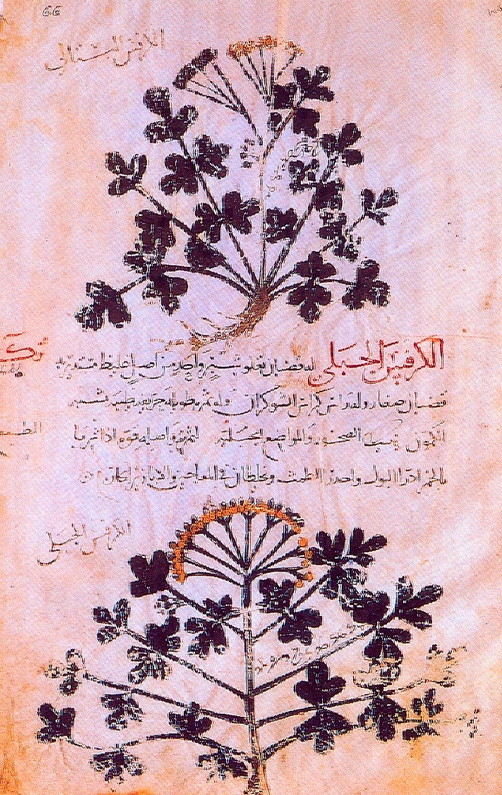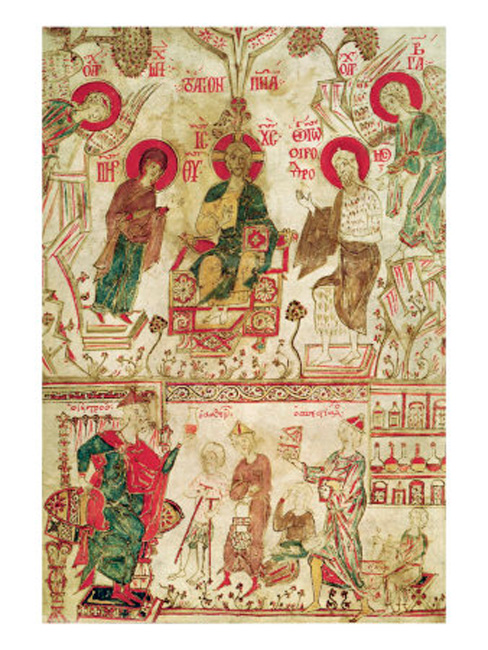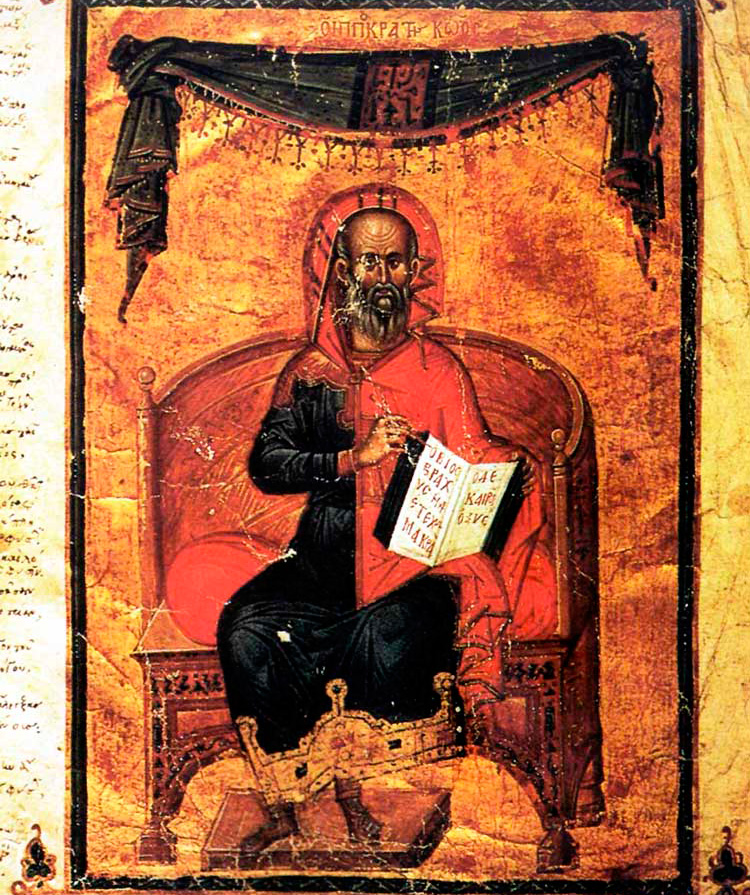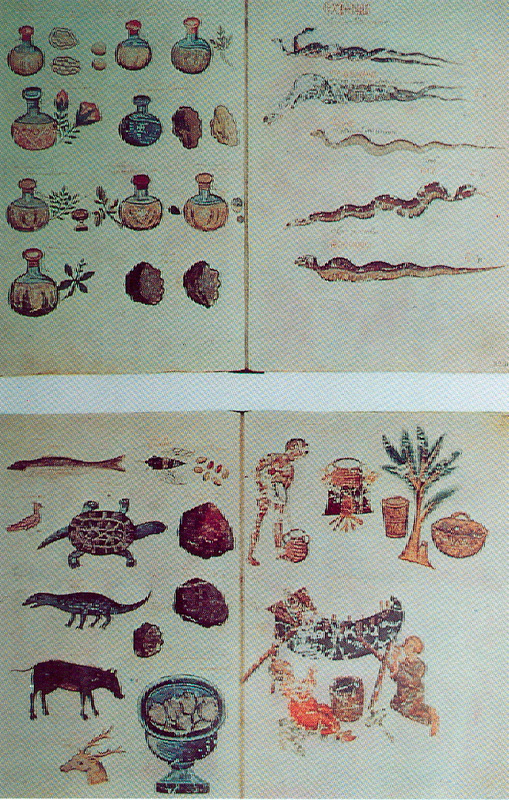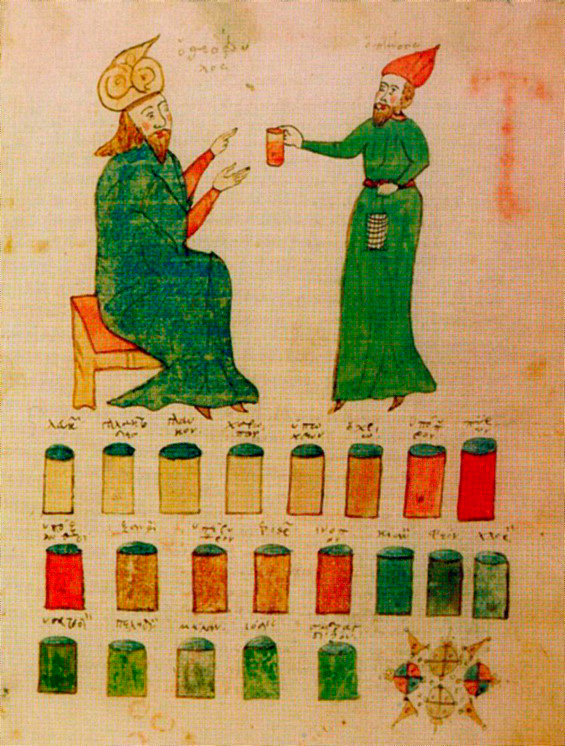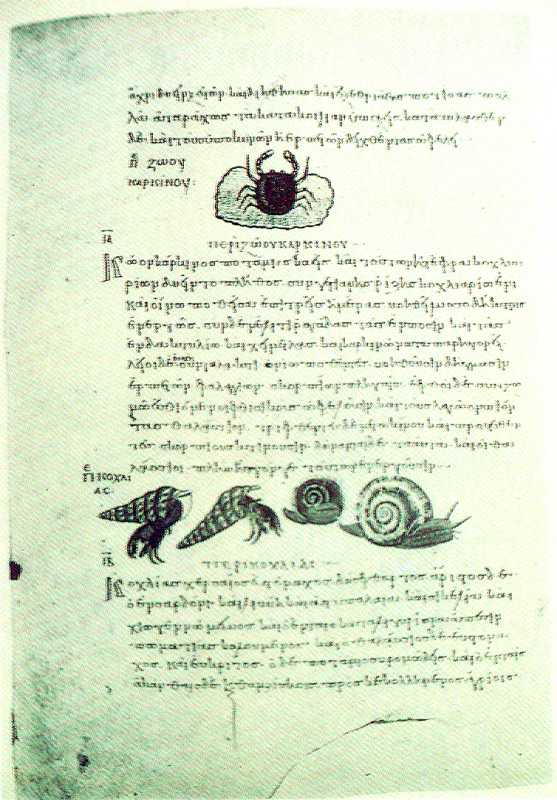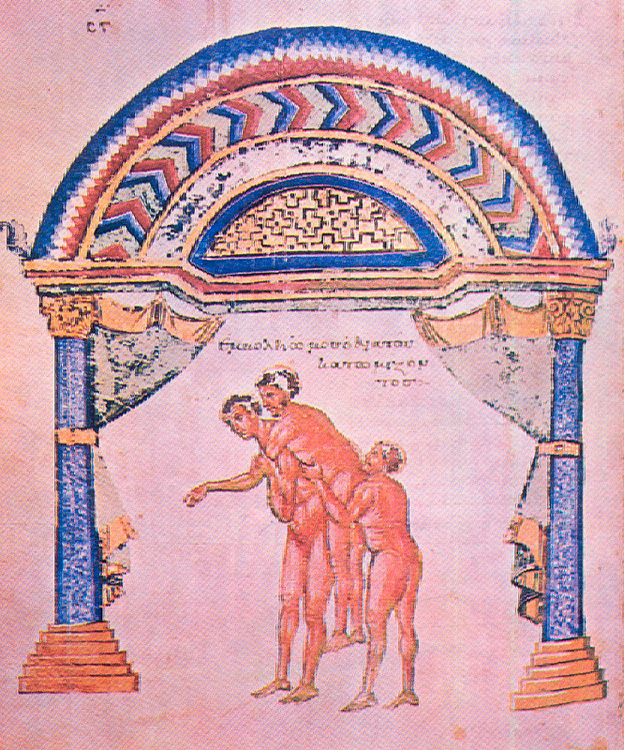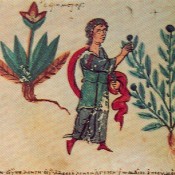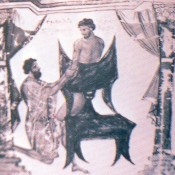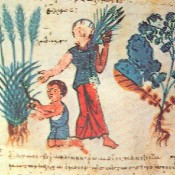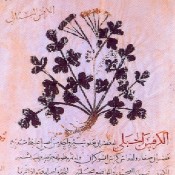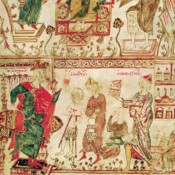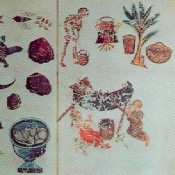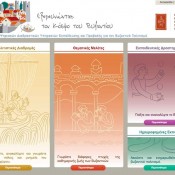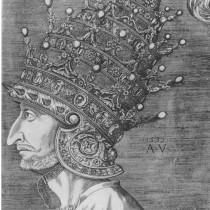The Byzantine medicine is an important bridge for the passage from the ancient Greek medicine in folk medicine until the 18th century. Medicine in Byzantium passed through several phases and has gradually evolved from art to science. Common representatives of medicine in Byzantium (note 1) are Oribasius Pergamenus (4os c.), Aetius Amidenus (6th c.), Alexander Trallianus (6th c.), Palladius Alexandrinus (6th c.), Paulus Aegineta (7th c.), Theophilus Protospatharius (7th c.), Stephanus Atheniensis or Alexandrinus (7th c.), Leo Constantinopolitana (Iατροσοφιστής) (9th c.), Paulus Nicaeensis (9th c.), Theophanes Non(n)us ( 10th c.), Symeon Seth (11th c.), Nicolaus Callicles (12th c.), Hierophilus Philosopher (12th c.), Nicolaus Myrepsus (13th c.) and Joannes Zacharias Aktouarius (14th c.).
It should be clarified that existing information about Byzantine medicine is originated in majority from the extant medical literature and secondarily detected in scattered passages in texts of other categories, such as letters, expressions, historiography (note 2). The difference lies in the fact that the content of medical texts is developed in theoretical scope, while the information of other texts usually involves the practice of medicine in the daily life in Byzantium. As a matter of fact, blending of information from both types of texts leads to safer conclusions about the formation of the relevant concepts and the practice of medicine during the Byzantine period.
In a detailed study of the sources the researcher finds that medicine in Byzantium evolves throughout the early and middle period and is organized as a science – under the meaning of the word at that time – in the late 10th and 11th century. Alexander Trallianus during the 6th century is the first Byzantine doctor who calls a doctor “scientist”: “(…) καὶ δεῖ πανταχόθεν βοηθεῖν τὸν ἐπιστήμονα καὶ φυσικοῖς χρώμενον ἐπιστημονικῷ λόγῳ καὶ μεθόδῳ τεχνικῇ” (note 3). However, this indication takes place in order to enable the author to justify in his work the parallel recording of prescriptions and related alchemical or magical recipes, always within the framework of the white-apotropaic magic (note 4).
An extremely important time for the evolution of medicine in Byzantium as a science is the 9th century, when physicians turned their interest in the study of the anatomy of the human body. This tendency for study and analytical description of human nature, as well as the dietary concepts that are formed on the basis of the anatomy of the human body, signify new methods in the writing of medical textbooks from the 9th century and onwards. Precursor of this process was partly the work of Alexander Trallianus, who followed a vertical path in the description of the diseases from the head to the ends of the human body.
The contribution of Leo Iatrosophista is initially based on the dealing of the work of monk Meletius (9th c.), also known as Iatrosophista. The text of Meletius Περὶ τῆς τοῦ ἀνθρώπου κατασκευῆς (note 5) is the first medical anatomical study. However the work of Meletius, as Hunger has pointed out, is not clearly characterised as medical, but it has more “teleological orientation” (note 6). So the contribution to the forming of medical concepts of his time was directly related to the use of the information provided by the medical perspectives of Leo Iatrosophista.
In order to understand the evolution of concepts of diseases and treatments in the 9th century, it is necessary to make a brief reference to the text of Meletius, before examining the contribution of Leo and Paulus in Byzantine medicine. It seems that Meletius used initially as a source the work of Nemesius, Bishop of Emesa (4th-5th c.) under the similar title: Περὶ φύσεως ἀνθρώπου (note 7) that is characterised as philosophical-theological work. Nemesius is dealing with the meaning of Christian anthropology, based on Plato, Aristotle and Plotinus with links to the Christian ideology (note 8).
The big step of Meletius is the parallel study and the use of the philosophical concerns of Nemesius, the medical theories of Hippocrates and Galen and the theological position of the Fathers of Church. As he states in the Προοίμιον (Ὑπόθεσις), his goal is the comprehensive and complete study of the human being as a trilateral whole: body – spirit – soul. It is also noted that neither the Greek physicians and philosophers nor the Fathers of the Church studied thoroughly and in detail this issue, as each one faced the issue from its own perspective and was content in what met his medical or theological pursuits. He announces also that by using all the previous individual knowledge, he will try extensively and with completeness to give a description of the human entity in an original text.
“Ὁ μὲν γὰρ Ἱπποκράτης περὶ φύσεως παιδίου καὶ ἀνδρὸς γράψας ὀλίγα τινὰ καὶ δυσδιάγνωστα, οὐδὲν περὶ τοῦ καθόλου ἀνθρώπου ἐμνημόνευσεν ἢ τῶν ἐν αὐτῷ δυνάμεων ἢ ἐνεργειῶν ἢ τῶν τοῦ σώματος μορίων. Ὁ γὰρ Γαληνὸς περὶ φύσεως μορίων μνησθεὶς καὶ περὶ κράσεων ἐν οὐδεμίᾳ τῶν πραγματειῶν αὐτοῦ φαίνεται τοιαύτην ὁλοκλήρως ὑπόθεσιν ἀναγράψας. Σωκράτης δὲ ἐτυμολογίας μᾶλλον μορίων καὶ ὀνομάτων ἐν τῷ περὶ φύσεως ἀνθρώπου συντάγματι αὐτοῦ, ὡς γραμματικὸς ἢ φιλόσοφος συνετάξατο. Οἱ δὲ ἅγιοι καὶ τῆς ἐκκλησίας διδάσκαλοι, οἷον ο μέγας Βασίλειος, ὁ ἀδελφὸς αὐτοῦ Γρηγόριος Νύσσης, ὁ χρυσολόγος Χρυσόστομος καὶ ὁ παμμακάριστος Κύριλλος καὶ ἄλλοι πολλοὶ τῶν κατ’ αὐτοὺς ἐν τοῖς λόγοις αὐτῶν τοῖς διδασκαλικοῖς σὺν τῷ θεολογικῷ φυσιολογήσαντες, πολλὰ περὶ τῶν τοῦ σώματος ἡμῶν μορίων καὶ τῶν ψυχικῶν καὶ ζωτικῶν καὶ φυσικῶν δυνάμεων καὶ ἐνεργειῶν συνεφιλοσόφησαν˙ οὐδεὶς μέντοι γε τῶν προειρημένων ἀνδρῶν ἢ τῶν ἁγίων τούτων συναγαγὼν φαίνεται τὴν ὅλην ὑπόθεσιν, τοῦ μὴ τὴν πραγματείαν ἀποτελέσαι˙ τὰ οὖν διεσπαρμένα, ὡς ἐν ταῖς τούτων βίβλοις ἐγκείμενα, αὐτὸς ἐκλαβών, τὸ παρὸν ὡς ἐνὸν συνεστησάμην δὴ σύγγραμμα˙ τοῖς μὲν ὡς εἰκὸς ἔχειν αὐτὸ βουλομένοις, ὑπόμνημα τῆς φύσεως καὶ τῆς συστάσεως τοῦ σώματος παντὸς ἐσόμενον” (note 9).
The text of Meletius is the first real attempt for a comprehensive study of human nature and its content is of great interest for the study of the concepts of the ontological hypostasis of man in the middle Byzantine period. In many passages of the text is obvious the blending of philosophical and medical views that derive from the ancient Greek civilization and the Christian concepts about man. Meletius considers humans as a unified mental-spiritual-physical entity destined for immortality and deification. He scrutinizes human nature by describing the anatomy of the body, the strengths and passions of the mind and soul, the senses, desires, inclinations and needs of man, the age phases and their manifestations from birth to death. He shows off self-knowledge as the highest spiritual conquest, which leads to the union with God and prosperity With reference to the anatomy of the human body he examines in detail the physiology of each part and organ and outlines the disorders and diseases that occur in each one of them.
It is noteworthy that in many cases he considers the display of the disorders as a result of a relationship conflicting between spirit – body and soul, when man is struggling enough to beat his physical weakness and be united with divine. The natural decay of the human body according to Meletius, follows necessarily the decay of spirit and soul. Unlike the death of the body offers immortality to human nature, if it is exempt from all perishable and ephemeral. The epilogue of the text is a kind of praise for the uniqueness of human nature and the Creator.
The work of Meletius, as mentioned, serves as the basis for writing the medical work of Leo Constantinopolitana, also known as the ἰατροσοφιστής, entitled Σύνοψις εἰς τὴν φύσιν τοῦ ἀνθρώπου (note 10). The author applying a rational method utilizes all medical information reported by Meletius, selectively adds elements from the Hippocratic medicine and supplements with a lot of new information from his personal experience as a physician. As stated in the subtitle of his work, he attempts to identify and describe the various aspects of human nature, the forces that compose and activate it, the age phases, the physical needs and their accusations, the human activities and inclinations. The text of Leo begins with an interesting etymological approach to the basic features of the human entity. The first characteristic passage is mentioned:
“Τί ἐστι ψυχή; οὐσία ἀσώματος, λογική, νοερὰ καὶ ἀθάνατος. τί ἐστιν ἄνθρωπος; ζῷον λογικόν, θνητόν, νοῦ καὶ ἐπιστήμης δεκτικόν. τί ἐστι ζῷον; οὐσία ἔμψυχος αἰσθητική. πόθεν ἄνθρωπος; παρὰ τὸ ἔναρθρον ἔχειν φωνὴν τῶν ἄλλων ζῴων ἀνάρθρως καὶ ἀσημάντως φωνούντων. καὶ ἄλλως παρὰ τὸ ἀθρεῖν καὶ λογίζεσθαι, ἅπερ ὄπωπε, τουτέστιν ἅπερ βλέπει· ἢ παρὰ τὸ ἄνω βλέπειν· ἢ παρὰ τὸ δρῶ, τὸ βλέπω, ἄδρωπος καὶ ἄνθρωπος· ἢ παρὰ τὸ ἄνω ῥέπειν, ἀνάρροπος. πόθεν ἔμβρυον; παρὰ τὸ ἔσω βρύειν, ὡς ἐνάλιον ζῷον παραπλήσιον· ἢ διὰ τὸ ἔνδοθεν τὴν βορὰν ἔχειν· ἢ διὰ τὸ ἔνδον εἶναι βροτόν. πόθεν μήτρα; παρὰ τὸ μήτηρ εἶναι τοῦ γεννωμένου. νηδύς, ὅτι μεθ’ ἡδύτητος ἐνεργεῖ· ἢ ἐκ τοῦ διανενεμῆσθαι, ὅ ἐστι σεσωρεῦσθαι καὶ πεπληρῶσθαι” (note 11).
The correlation of natural components of the human body by the person’s age, the elements of nature and climatic conditions is one of the most interesting theories in the work of Leo, which is based on the nutritional aspects, formed over time and after the 10th century in the minds of the Byzantine physicians. This theory has its origin in Hippocrates (note 12) and is expressed in a first form by Galen (note 13), but it is not practically applied in medical instructions on nutrition and health. In the same correlation the previous Byzantine physicians were certainly regarding the causes of various diseases, as for instance Oribasius in the wording of his original theory on the transmission of πανδήμων (pandemic) diseases by inhaled air (note 14).
However the new element in the work of Leo is the direct connection of the nutritional needs of humans with the physical condition and age, the time of the year and the climatic conditions. This correlation can be expressed diagrammatically as follows:
Πῦρ – θέρος – θερμότητα – ξανθή χολή = Παιδικὴ ἡλικία
Ἀήρ – ἔαρ – ὑγρότητα – αἷμα = Ἐφηβεία / Νεανικὴ ἡλικία
Ὕδωρ – χειμών – ψυχρότητα – φλέγμα = Ὥριμη ἡλικία
Γῆ – φθινόπωρο – ξηρότητα – μέλαινα χολή = Γῆρας
Also very important work of Leo is the Σύνοψις Ἰατρική, which establishes a new method of editing the medical textbooks and contributes to the development of concepts about diseases and treatments in Byzantium from the 9th century and onwards (note 15). Ιn the Προοίμιον of the work, the author addressed to someone named George, who apparently asked him to draft the text:
“Οὐχ ἅπαξ, οὐδὲ δὶς, ἀλλὰ καὶ πολλάκις ᾔτησάς με, γνησιώτατε Γεώργιε, ὅσα φοιτῶν ἐν ταῖς διατριβαῖς μεμάθηκας ἰατρικὰ θεωρήματα, ταῦτά σοι διὰ βραχέων ἐπελθεῖν ὑπομνήσεως ἕνεκα. Ἐγὼ δὲ ταῖς τῶν φίλων ἑτοίμως ὑπακούων αἰτήσεσι πειράσομαί σοι πᾶσαν, ὡς εἰπεῖν, τὴν ιατρικήν ἐπελθεῖν, πάσης μὲν συντομίας ὁμοῦ καὶ σαφηνείας ἐπιμελούμενος, μηδὲν κατὰ δύναμιν τῶν ἀναγκαίων ὑπερορῶν· γελοῖον γὰρ ἀναμιμνήσκειν ἐθέλοντα ἀσαφῶς καὶ μὴ διὰ πολλῶν ἑρμηνεύειν τὰ πράγματα” (note 16).
Leo in this work encodes diseases in categories with criteria on one hand the anatomy of the human body and on the other by age, season and climatic conditions under which every disease occurs. In Σύνοψις Ἰατρικὴ one hundred eighty sections are included, organized into seven λόγους (chapters), each of which refers to a part of the human body. The individual sections of each chapter bear titles disease names that appear in this part of the body. The author describes the symptoms of each disease and its causes and at the same time he proposes treatments for each disease through diet and herbs. The method is described in the Prooimion of the text: “Ἕκαστον τοίνυν τῶν παθημάτων ἐκθέμενος πρῶτον, μετὰ ταῦτα τὰς αἰτίας ὑπαγορεύσω σαφῶς· δεύτερον δὲ τὰ σημεῖα δι’ ὧν ῥᾳδίως γνωσθήσεται· τρίτον τὴν θεραπείαν, δι’ ἣν ἅπαντα κατὰ τὴν τέχνην σπουδάζομεν” (note 17).
It is noteworthy that the Leo spends more time in the description of diseases and their causes and less on their treatment. This practice shows that the Byzantine physician is based on prevention rather than on treatment of diseases. A typical passage is quoted:
“Περὶ πλευρίτιδος. Πλευρῖτίς ἐστι φλεγμονὴ τοῦ ἔσωθεν ὑπεζωκότος ὑπειληφότος τὰς πλευρὰς ὑμένος. σημεῖα δὲ τῆς πλευρίτιδος τὰ λεγόμενα ὑπὸ τῶν δογματικῶν παθιγνωμικὰ τέτταρα· βὴξ, δύσπνοια, πυρετὸς ὀξὺς, ὀδύνη νυγματώδης·ἔστι δὲ ὀδύνη νυγματώδης, ὡς εἴ τις ψηφῖδα ῥίψας ἐν ὕδατι ποιήσειε κύκλον ἀεὶ μεγεθυνόμενον καὶ φεύγοντα ἀεὶ τὸ κέντρον αὐτοῦ, καὶ δεῖ καταρχὰς μὲν ζεματίοις χρῆσθαι ὑσσώπου, γλυκυρίζου καὶ τῶν τοιούτων, ἔξωθεν ἐπὶ τῆς πλευρᾶς πυρίᾳ τε καὶ σακελλισμοῖς· ἔστι δὲ καὶ ὅτε φλεβοτομοῦμεν· προκόπτοντος δὲ τοῦ χρόνου λεπτῶς πάνυ διαιτῶμεν, οἷον πτισάνῃ χρώμενοι” (note 18).
It is very interesting that in the same period similar concepts appear in other types of texts, demonstrating that the positions of doctors had rather widely influenced the environment of Byzantine scholars. A typical example is the reference of Theophylactus of Ohrid (12th c.) to the bad condition of his health, that is attributed to the difficult climatic conditions and diet: “Τοῦ γὰρ ἐν Ἀχρίδι ἀέρος τὸν ἐνταῦθα ἀλλαξάμενος, τοῦ τ’ ἐν ἐκείνῃ ὀλιγοφόρου οἴνου καὶ λεπτοτάτου καὶ τῶν ἄλλων ὑγιεινοτέρων τροφῶν στερηθείς, κακῶς ἔχει τὸ σῶμα, καὶ πάνυ πονήρως πέπραγεν· ἀνορεξίας μὲν εἰς ἔσχατον ἥκων, κεφαλαλγίᾳ δὲ προσπαλαίων, καὶ τὴν γαστέρα χυμῶν ἔμπλεω περικείμενος” (note 19).
Τιμαρίων makes also a similar comment in the homonymous text (12th c.), where with a satirical manner criticizes the strict diet imposed to him by doctors in order to be treated by a serious disease. The diet, however, deprived him of the four fluids that his organism should have: “Ποῦ γὰρ εἰκὸς ἄνευ τῶν τεσσάρων στοιχειωδῶν χυμῶν ἄνθρωπον ζῆν τὴν ἄνω καὶ παρὰ τὸν βίον ζωήν;” (note 20).
Finally a very special and rare animal species classification, based on the same criteria, is made by the Arethas of Caesarea (10th c.) in order to explain their physiology: “(…) εἰ δὲ κατ’ ἐπικράτειαν τοῦ μὲν πυρός, γίνεται τὰ θυμοειδὴ τῶν ζῴων, ὡς λέοντες καὶ παρδάλεις· τοῦ δὲ ὕδατος, τὰ δειλότερα τῶν ζῴων, ὡς ἔλαφος, λαγωοί· τοῦ δὲ ἀέρος, τὰ πτηνά, ὡς ἀετοὶ καὶ γῦπες· τῆς δὲ γῆς, τὰ γεώδη καὶ βαρέα, ὡς ἄρκτοι, σύες καὶ τὰ παραπλήσια” (note 21).
As it is mentioned, Leo’s work points out a new era for the Byzantine medical literature and is the basis for the formation of two new methods of writing medical texts. The first is the one applied by Leo himself in Σύνοψις Ἰατρική, namely the description and classification of diseases by the mentioned criteria and their treatments. The second is developed initially by Symeon Seth (note 22), the 11th century and forms the so-called dietary manuals. I consider the concepts of nutritional therapy in Leo’s Ἰατρικὴ Σύνοψι as essential for the formation of the Συντάγματος περὶ τροφῶν δυνάμεως by Seth, which then will become the standard for the alphabetical and by month dietary manuals of Hierophilus (note 23) and other doctors of the 11th century and onwards.
The Σύνοψις Ἰατρικὴ by Leo possibly was the standard for Paulus Nicaeensis, who probably lived in the late 9th early 10th century. Paulus drafts a work entitled extensively as: “Περὶ πολλῶν καὶ ποικίλων γενομένων νοσημάτων ἀναριθμήτων τε συμπτωμάτων περὶ τὰ ἀνθρώπινα σώματα, ποτὲ μὲν ἀπό διαφόρων ἀέρων, ποτὲ δὲ καὶ ἀπ’ αὐτῶν. τῆς φύσεως τῆς συνεχούσης τὸ ζῷον πανταχόθεν ἀναλυομένης, ἔτι δὲ καὶ διαίτης καὶ τῶν ποιοτήτων ὧν γε προσφερομένων” (note 24).
Paulus sets up a broad medical encyclopaedia containing one hundred and thirty three chapters, each of which is divided into two sections: the first bears the title of the chapter, for example, Περὶ ἰσχιάδος. This section describes in detail each disease, the causes and the symptoms. Then the second section under the typically repetitive title: Πῶς οὖν θεραπεύσῃς offers therapeutical instructions through herbs and animal products (note 25).
Paulus work is more detailed in the description of diseases and treatment instructions than Leo’s. The difference in the number of chapters between the two works is due to the fact that Paulus compiles some diseases, such as the various forms of arthritis or intestinal diseases, in a chapter and he proposes common treatments. This method obviously indicates an evolution in perceptions about diseases and their treatment. In contrast to Leo, Paulus focuses on the treatment of diseases and he does not refer to prevention. I think the most important element in the work of Paulus is the large number of raw materials from plants and animals included in the proposed pharmaceutical preparations. Many of them appear for the first time in his work after Oribasius and it seems he has rejected pre-existing treatment instructions under the light of his personal experience.
Of particular interest are the table of contents that precedes the text and the Προοίμιον of Paulus. The table of contents lists the titles of the 133 chapters of the work, which concern the names of the diseases and their anatomical insertion in the text. It is a handy index for each known disease and its treatment in the 9th century.
In the Προοίμιον Paulus appears as a writer of his own, as he does not mention, like other Byzantine physicians, that the essay is written by order of a friend interested or a student or in order to devote it to the Emperor or someone official (note 26). Particular originality of Paulus is the scientific orientation of the Προοίμιον, as it presents as a major cause of diseases the atmosphere and the climatic changes affecting human temperament: “Ὁ δὲ περιέχων ἡμᾶς ἀὴρ ἔξωθεν περικεχυμένος συνεχῶς ἡμῶν τρέπει τὰς κράσεις· θερμότερον ἢ ψυχρότερον ἢ ξηρότερον ἢ ὑγρότερον γινόμενος χαλεπώτατα τίκτει νοσήματα, ὅθεν καὶ ἐπιγίνονται κάταρροι, κυνάγχαι, ῥευματισμοί, βράγχοι, κόρυζαι, βῆχες, περιπνευμονίαι, πλευρίτιδες, στηθῶν πόνοι, ὀξεῖς πυρετοὶ καὶ τὰ τούτοις ὅμοια” (note 27). Furthermore, the author underlines and highlights the importance and contribution of medicine to the diagnosis and treatment of diseases: “ἡ φιλανθρωποτάτη δὲ ἰατρικὴ πολυπλασίονας ὅλων τὰς θεραπείας ἔχει ἀναρίθμητά τε νοσήματα προσηνέγκατο κατὰ τῶν συνειδότων ἐφευρίσκειν” (note 28).
Although he writes a clearly scientific text of his era, he calls medicine τέχνη (art) and not a επιστήμη (science), as his former Alexander Trallianus. At this point it should be mentioned that since antiquity, Aristotle includes medicine among sciences (note 29) and in the Byzantine dictionaries the term is mentioned with Aristotle’s meaning, while as τέχνη (art) the ο δόλος (fraud) is determined (note 30). The choice of Paulus is probably justified by the fact that he perceives the term τέχνη (art) with the meaning attributed today to what we call know-how, namely as regards medicine, the knowledge and use of natural raw materials, plant and animal, especially the preparation of medicines from them for the various treatments: “ὅθεν τὰ μέγιστα ἡ τέχνη τῆς ἰατρικής, διὰ τὸ τὴν ὕλην προισταμένην καὶ τὰς δυνάμεις τῶν βοηθημάτων ἀκριβῶς ἐπίστασθαι, οἷά τε τοῦ κάμνοντος ἤτοι παρόντων ἑτέρων ιατρών, ἔχει τι ἀποκρίνασθαι τά τε δυνάμενα βοηθεῖν ἐπὶ τῶν καμνόντων” (note 31).
All the text of Paulus is characterized by a systematic effort to apply proper treatments as he describes in detail the symptoms of each disease and records in every case a very broad list of medicinal raw materials which with proper mixing and making up become therapeutical medicines for each disease. For the better approach of Paulus text I cite a passage with the two characteristic sections, the descriptive and the therapeutical, the sixteenth chapter Περὶ ἡμικρανίας.
“Τί ἐστι ἡμικρανία; πόνος ἐστὶν καὶ αὐτὸς περὶ τὸ ἥμισυ μέρος τῆς κεφαλῆς γιγνόμενος καλούμενος δὲ καὶ συνήθης ἡμικρανία. ἐνίοις μὲν ἔξωθεν τοῦ κρανίου αἴσθησις γίνεται, ἐνίοις δὲ εἰς τὸ βάθος τῆς κεφαλῆς διήκει ὁ πόνος. διορίζεται δὲ ἑκάτερον τὸ μέρος τῆς κεφαλῆς δεξιᾷ τε καὶ ἀριστερᾷ, ἀτμώδους θερμοῦ χολώδους κατὰ τὸ στόμα τῆς κοιλίας ἀθροιζομένου ἐν τῷ ἡμικράνῳ.
”Πῶς οὖν θεραπεύσῃς. Τὴν μὲν οὖν ὅλην ἐπιμέλειαν ἣ προσεπὶ κεφαλαλγίας εἴρηται ἐπὶ τοσοῦτον ποιήσομαι, ἐμβροχαῖς τε καὶ καταπλάσμασιν δι’ ἐλαίου ῥοδίνου ἢ χαμαιμηλίνου ἢ πηγανίνου καὶ τῶν ομοίων. ἐνίοτε παραμιγνύων αὐτοῖς χυλὸν ἀειζώου ἢ ἀρνογλώσσου ἢ βάτου ἢ ἀνδράχνης ἢ ἑλξίνης, καὶ καλαμίνθου ἀπόζεμα ἢ ὀριγάνης ἢ ὑσσώπου ἢ γλήχωνος, κρίνου ῥίζαν καὶ νίτρον καὶ λάδανον σὺν οἴνῳ καταπλάσω· καὶ ὁμοῦ διαιτήσω” (note 32).
The medical writings of Leo and Paulus seem to have a determinative impact on the later doctors in Byzantium. The dismissal of each element of white-apotropaic magic or alchemy is evident in their works, followed by almost all the major physicians of the middle and late period, such as Symeon Seth (11th c.), Nicolaus Myrepsus (13th c.) and Joannes Zacharias Aktouarius (14th c.). Theophanes Non(n)us ( 10th c.) is an exception, as he is the last Byzantine doctor who in his work the Ἰατρικὴ Σύνοψις includes instructions for white magic, however his medical prescriptions are clearly influenced by the work of Paulus Nicaeensis and in the layout of diseases he follows the method of Leo. The later Byzantine pharmacist Nicolaus Myrepsus, whose famous Δυναμερὸν ἤτοι περὶ συνθέσεως φαρμάκων remains unpublished, uses as its main source the prescriptions of Paulus for the structure of this exclusive type of pharmaceutical manual. Finally, the scientific view of disease, the marking of the importance of the psychosomatic balance for the improvement of human health and the application of proper treatment method, elements running through the works of Leo and Paulus are obvious in the medical texts of Joannes Zacharias Aktouarius (note 33) the late period. Of particular interest is the theological and philosophical relationship, which Joannes Zacharias Aktouarius puts in his work Περὶ ἐνεργειῶν καὶ παθῶν, whereby the therapautical properties of the parts of the animals show the divine essence that is inherent in human nature: “Ἀπόδειξις ἐκ τῶν κατὰ μέρος ἰδιοτήτων τῶν ἀλόγων ζῴων, ὅτι ἐν ἡμῖν θεία τις οὐσία” (note 34). This correlation clearly refers to the position of Meletius Iatrosofista, adopted also by Leo on the unified human psychosomatic entity whose balance is necessary for obtaining and improving health.
The contribution of Leo and Paulus in forming perceptions of diseases and treatments in Byzantium I believe it was determinative. Their texts are characterised by strictly scientific structure and organised content in comprehensible sections. It is the first time in the Byzantine period that instructions and prescriptions of white magic and amulets are completely absent in these works, which is a fact signalling also an important evolution for medicine not only in Byzantium but in the middle Ages in general. After the 9th century the Byzantine medical literature follows the standards of Leo and Paulus. They are concise, comprehensive and mostly free from superstition elements.
Dr. Maria Chrone
Byzantine Philology (University of Athens)
